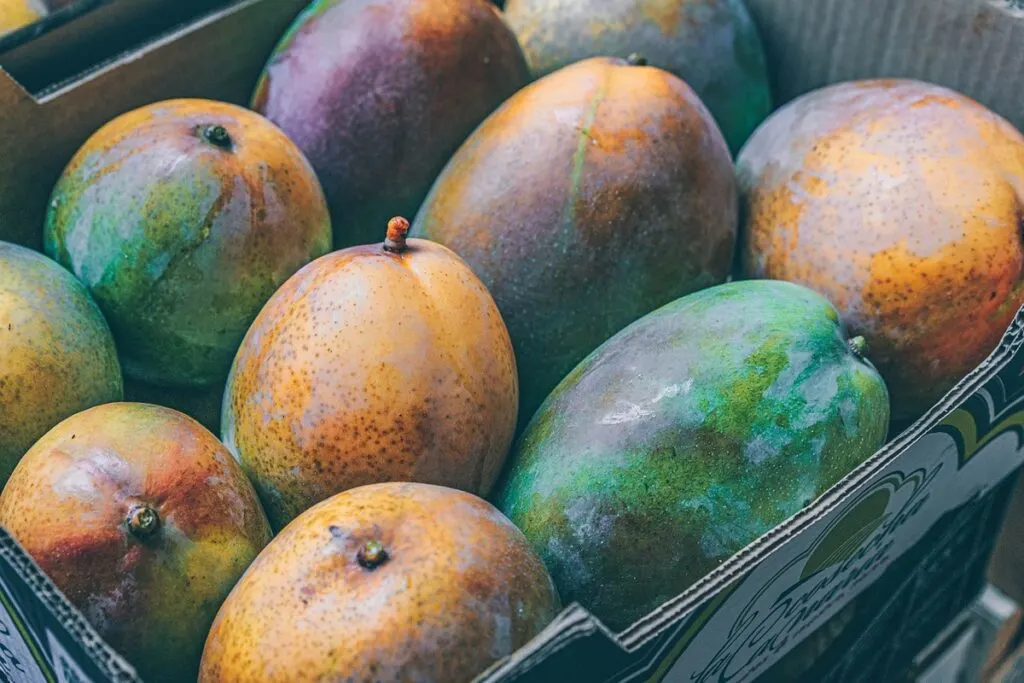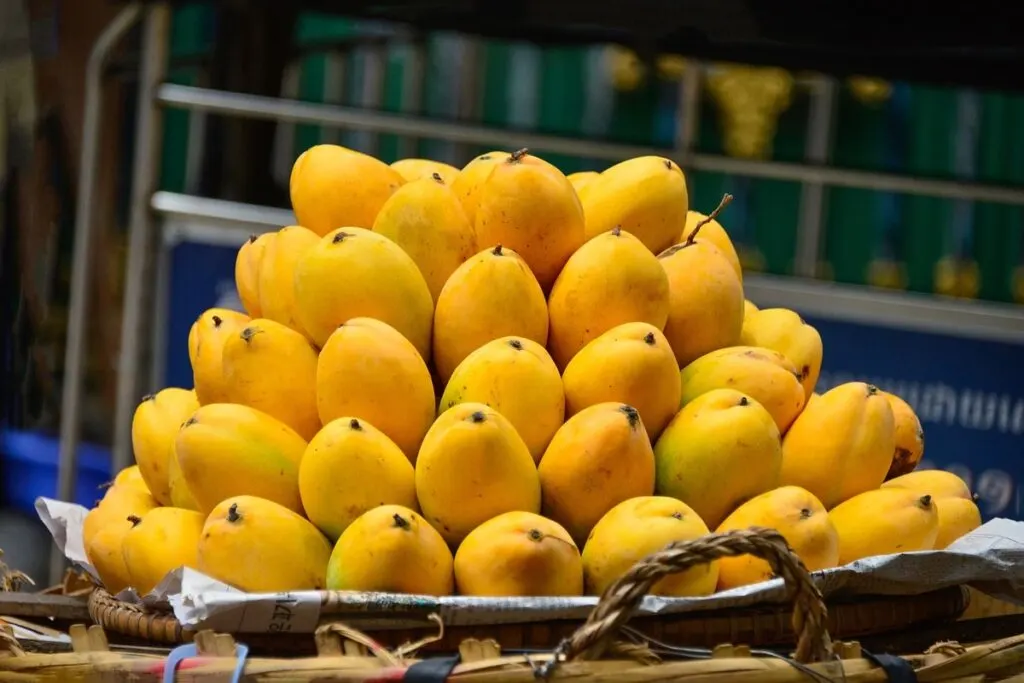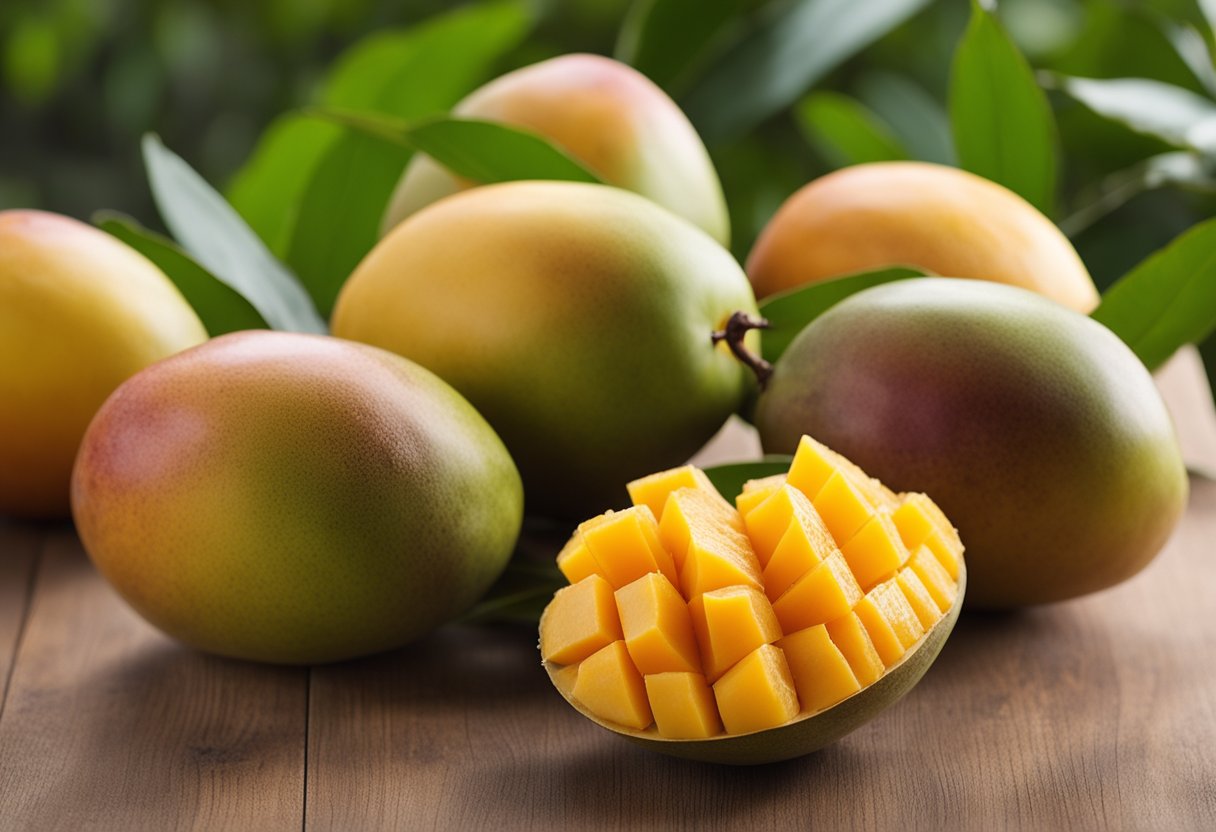Mangoes are a delicious and tropical fruit enjoyed by many across the globe. However, determining when a mango is ripe and ready to eat can be a bit challenging for some.
It is essential to identify a ripe mango because it greatly impacts the fruit’s taste, texture, and overall enjoyment.

There are various methods to determine if a mango is ripe, but one common and reliable technique is to focus on the fruit’s feel rather than its color.
Mango varieties have different colors when ripe, so the key to selecting a ripe mango is by giving it a gentle squeeze. A ripe mango will slightly give way, indicating that the soft, juicy flesh inside is ready to consume.
Another helpful tip is to evaluate the aroma of the mango. A ripe mango will emit a sweet, fruity smell, reminiscent of pineapples and melons.
To do this, simply sniff the fruit near the stem where the scent is strongest. Combining these methods allows for a better understanding of when a mango is at its peak ripeness, ensuring a delightful eating experience.
Related: How to Know if Persimmon is Ripe: Simple Expert Tips
Understanding mango varieties
When it comes to selecting a ripe mango, understanding the different mango varieties can be quite helpful. Mangoes are a popular tropical fruit known for their sweet taste, vibrant colors, and juicy texture. This section will briefly highlight some of the well-known mango varieties and their unique characteristics.
Ataulfo mangoes, also known as Champagne or Honey mangoes, are a smaller variety with a golden-yellow skin and delicate, velvety texture. They have a sweet flavor with minimal fibers, making them great for fruit salads, smoothies, and desserts.

Tommy Atkins is a widely available mango variety, featuring a dark red skin with some green and orange hues. They have a firm, fibrous texture and a mildly sweet flavor. Tommy Atkins mangoes are ideal for juicing and using in chutneys or salsas.
Haden mangoes are medium to large in size and have a bright red or orange skin with hints of golden yellow. Their juicy, slightly fibrous flesh has a rich, sweet taste, making them perfect for eating as is or incorporating into various recipes.
Keitt mangoes are known for their large size and unique green skin, which remains green even when ripe. They have a firm, buttery texture and a sweet, tangy flavor that lends itself well to both sweet and savory dishes.
Kent mangoes feature a dark green skin with a slightly red blush and are considered one of the juiciest varieties. They have a smooth, fiber-free texture and a rich, sweet taste, making them excellent for enjoying on their own or in indulgent recipes.
Palmer mangoes are known for their elongated shape and reddish-purple skin. Their firm, bright orange flesh has a mildly sweet taste, and their minimal fibers make them versatile for many culinary applications.
Each of these mango varieties offers a unique combination of appearance, texture, and flavor. Knowing their specific characteristics can make it easier for you to identify and select a ripe mango that best suits your taste preferences and recipe needs. When choosing a mango, consider factors like color, aroma, and firmness to ensure you pick a ripe, delicious example of your desired variety.
Related: How to Know if a Pomegranate is Ripe: A Simple Guide
Identifying a ripe mango
Knowing how to identify a ripe mango is essential for enjoying its sweet and juicy taste. A ripe mango has a few key characteristics that can help you determine if it has reached the perfect stage for consumption.
First, check the color of the mango. A ripe mango will usually have a vibrant and glossy appearance.
Depending on the variety, ripe mangoes can range from yellow, orange, red, or green. Keep in mind that color alone may not be a reliable indicator, as some varieties may not change color significantly as they ripen.

Next, give the mango a gentle squeeze. A ripe mango will yield slightly under gentle pressure, whereas an unripe mango will feel firm and hard. On the other hand, if the mango feels overly soft or soggy, it might be overripe and past its prime.
Another way to assess the ripeness is by observing the skin around the mango’s stem. If it is round and plump, the mango is likely to be ripe, and if it is flat or sunken in, the mango is unripe.
Another indicator of a ripe mango is its aroma. A ripe mango will emit a pleasant, fruity scent near the stem, indicating that it is ready to eat. If there’s no aroma or a weak scent, the mango might still need some time to ripen. In contrast, if the scent is too strong or has a slightly fermented smell, the mango may be overripe.
In conclusion, identifying a ripe mango involves examining its color, texture, and aroma. By considering all these factors, you can confidently select a delicious and perfectly ripe mango that’s ready to be enjoyed.
Physical indicators of ripeness
In this section, we will discuss various physical indicators that can help you determine if a mango is ripe and ready to eat. Mangoes are a delicious and nutritious fruit, but their taste and texture can vary greatly depending on their ripeness.
Color indicators
While mangoes come in a range of colors, including green, yellow, and red, the color alone is not always the best indicator of ripeness.

Nevertheless, ripe mangoes tend to have a yellowish or reddish hue, showing more vibrant colors compared to unripe ones. Green mangoes can still be ripe if they exhibit other signs of ripeness, such as softness and aroma.
Feel and touch indicators
The texture and firmness of a mango can be more reliable indicators of ripeness. To check for ripeness, gently squeeze the mango.
A ripe mango should give slightly under your fingers, while an unripe mango will feel firm and hard to squeeze. If you can just barely make a dent in the fruit when you press it with your thumb, it is ripe and ready to eat.
Aroma indicators
A ripe mango will give off a sweet, fruity aroma, particularly near the stem. To check for ripeness, smell the area around the stem of the mango.
An unripe mango will have little to no smell. On the other hand, a ripe mango will have a pleasant and strong fragrance.
Signs of an overripe mango
It’s essential to distinguish between ripe and overripe mangoes to avoid unpleasant surprises. Overripe mangoes will feel too soft, almost mushy, and may have numerous soft spots.
Their smell may also change, becoming sour or having an alcoholic odor. These are signs that the mango is spoiled and not suitable for consumption.
By paying attention to these physical indicators, you can confidently select ripe mangoes for a delicious and enjoyable eating experience.
Cutting and tasting the mango
Cutting a mango properly is essential to assess its ripeness and enjoy its sweet and juicy flesh.
To cut a mango, first, locate the stem and make two vertical cuts on either side, about 1/4 inch away from the midline where the flat seed runs from stem to nose. This will give you two mango lobes ready to be examined for ripeness.

When determining if a mango is ripe, pay attention to its texture and flavor. A ripe mango will have a slightly soft and yielding flesh, similar to that of a peach.
If the mango is too firm or hard, it is unripe and not ready to be consumed. On the other hand, if the flesh is too mushy or has a lot of soft spots, the mango has most likely gone bad.
The flavor of a ripe mango is undeniably sweet and fruity. Tasting the mango is one of the most reliable ways to determine its ripeness.
As you eat the fruit, you should notice a rich and juicy sweetness accompanied by a touch of tartness. An unripe mango, in contrast, will be less sweet and have a more astringent taste.
In addition to the taste and texture, the aroma of a mango can also provide clues to its ripeness. A ripe mango typically exudes a sweet, fruity aroma near the stem end. If the mango lacks a pleasant smell or has an off-putting odor, it may be a sign that the fruit is not yet ripe or has gone past its prime.
By mastering the art of cutting a mango and paying close attention to its texture, flavor, and aroma, you can confidently determine if the mango is ripe and ready to be enjoyed.
Ripening and storing mangoes
Ripening unripe mangoes
To ripen unripe mangoes, you can use the paper bag method. Place the mangoes in a paper bag or wrap them in newspaper and leave the bag on the kitchen counter overnight.

Mangoes release ethylene, an odorless gas that speeds up the ripening process. This method also works well for ripening avocados. Check for ripeness in the morning by gently squeezing the mango. If it gives way slightly and feels slightly soft to the touch, it’s ripe.
Storing ripe mangoes
Once your mangoes are ripe, it’s essential to store them correctly to maintain their quality and prevent spoilage. Keep ripe mangoes at room temperature on the counter if you plan to consume them within a day or two.
For longer storage, ripe mangoes can be placed in the refrigerator. Before refrigerating, store them in a plastic bag or wrap them in plastic wrap to prevent them from absorbing odors from the fridge.
For extended storage beyond a few days, you can also freeze mangoes. To do this, simply peel and cut the ripe mango into cubes or slices, then place them on a parchment paper-lined tray and freeze for about two hours.
Once the mango pieces are frozen, transfer them to an airtight freezer-safe container or resealable plastic bag and store them in the freezer. This way, you can enjoy your ripe mangoes for months to come.
Differentiating mangoes from similar fruits
Mangoes are a popular tropical fruit, often compared to fruits like avocados, peaches, and bananas due to their size and shape. However, these fruits have distinct characteristics that set them apart from one another. In this section, we will discuss how to differentiate mangoes from similar fruits, focusing on their appearance, texture, and flavor.
Mangoes are oval-shaped fruits with a smooth, colorful skin that can range from yellow to orange, red, or green when ripe. Their pulp is juicy and sweet with a unique flavor that is difficult to replicate. Mangoes have a large, flat seed in the center, which distinguishes them from other fruits.
Avocados have a similar shape to mangoes, but their skin is typically dark green and rough. Additionally, avocados have a large, round seed, whereas mango seeds are flat. Although avocados are also considered a tropical fruit, their taste is very different from mangoes, as they have a mild, creamy texture and subtle flavor.
Peaches are smaller than mangoes, with a distinctive fuzzy skin. They can be orange, red, or yellow, but the fuzziness sets them apart from mangoes.
Peaches are known for their sweet, tangy flavor and smooth texture. Their central seed is small and hard, differentiating them from mangoes.
Bananas are also tropical fruits, but they have an elongated shape that makes them easily distinguishable from mangoes. The skin is bright yellow when ripe and easily peelable, revealing a sweet, soft, and creamy flesh. Bananas are high in carbohydrates, while mangoes are richer in vitamins A and C.
By understanding these key differences, it becomes easier to identify mangoes and separate them from similar fruits. Their distinct appearance, texture, and flavor make mangoes a unique and beloved tropical fruit worldwide.
Cooking with ripe mangoes
Ripe mangoes are a delicious and versatile ingredient for various dishes. They are perfect for experimenting with different mango recipes, ranging from savory entrees to sweet desserts. In this section, we will explore some of the ways to incorporate ripe mangoes into your cooking.
One way to showcase the sweet tropical flavor of ripe mangoes is in a refreshing mango salad. Start by peeling and chopping ripe mangoes into bite-sized pieces and then mix them with chopped red onion, cilantro, and jalapeño.

To create a zesty dressing, whisk together lime juice, olive oil, honey, and salt. Drizzle the dressing over the salad and toss to combine. Serve chilled, allowing the flavors to meld together for a dish that is both sweet and savory.
Mangoes pair exceptionally well with their juicy texture and sweetness in fruit salsas. Simply dice ripe mangoes and combine them with other fruits like pineapple or strawberries.
Add in minced red onion, cilantro, and some lime juice for a tangy kick. Enjoy this fruity concoction as a topping for grilled fish or chicken, or serve it with tortilla chips at your next gathering.
For a healthy snack or dessert option, consider blending ripe mangoes with a bit of yogurt and honey to create a mango smoothie or parfait. Layer the puree with granola and additional fruit for added texture and flavor. You can also freeze the mango mixture in popsicle molds for a cool and refreshing summer treat.
Another delicious way to enjoy ripe mangoes is to incorporate them into baked goods, such as muffins or cakes. To do this, fold diced mangoes into your favorite batter, adding a touch of cinnamon or nutmeg for a warm spicy note. The result is a moist, tender, and fruity explosion of flavors that are sure to please anyone’s taste buds.
Finally, ripe mangoes can be cooked in sauces, stir-fries, and salad dressings, adding a tropical twist to familiar dishes. For example, a mango chutney served with grilled meats or atop a veggie burger adds an exotic flair to an everyday meal.
In conclusion, ripe mangoes are a versatile fruit that can enhance a variety of recipes. Their understanding of sweetness, juiciness, and vibrant color make them a standout ingredient in both sweet and savory dishes. So go ahead, slice open a ripe mango and explore the endless culinary possibilities.
Dealing with overripe or spoiled mangoes
Overripe and spoiled mangoes are often associated with an unpleasant taste and texture, which can negatively affect your culinary experience. Identifying the signs of overripe or spoiled mangoes can help you avoid waste and ensure that you consume mangoes at their peak.

An overripe mango may feel very soft to the touch, with the skin appearing wrinkled and having a few dark marks. In some cases, the fruit might give off a strong, overly sweet smell.
Overripe mangoes can still be consumed, but they are better suited for recipes that call for the fruit to be mashed or pureed, such as smoothies or chutneys.
On the other hand, a spoiled mango will exhibit more concerning indicators. The area around its stem might be sunken, oozing sap, or darker in color.
A spoiled mango will emit a sour, rotten, and unappetizing smell, particularly near its stem. Consuming a spoiled mango is not advisable, as it can lead to foodborne illness. In such cases, it is best to discard the fruit properly and avoid consumption.
To extend the shelf life of a ripe mango, store it in the refrigerator. This can give you approximately five days to consume the fruit in its best condition. However, refrigeration might not be the best option for overripe or spoiled mangoes, as they will continue to deteriorate and pose potential health risks.
In summary, distinguishing between overripe and spoiled mangoes is crucial for a better eating experience and preventing food waste. Pay close attention to the signs mentioned above and adjust your storage methods accordingly to enjoy mangoes at their prime.
